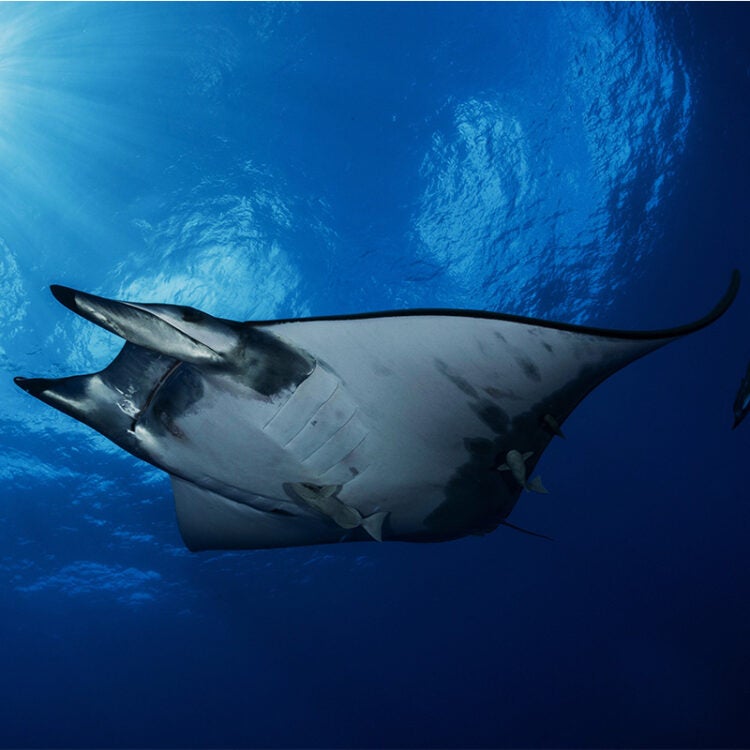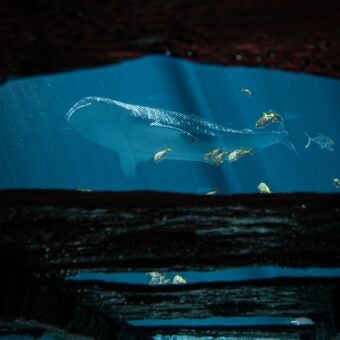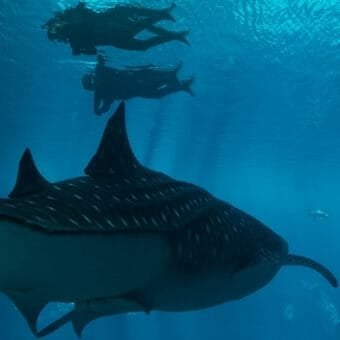-
Size
4 feet (1.2 m) -
Diet
Planktonic crustaceans and small schooling fishes -
Range
Western Atlantic, Gulf of Mexico and Caribbean -
Habitat
Tropical and warm temperate waters
Physical Characteristics
- Can grow to about 4 feet (1.2 m) in width.
- The lesser devil ray has a unique body shape very similar to that of the more familiar manta ray: a diamond-shaped outline with a wide mouth flanked by two broad, flexible, fleshy cephalic lobes. However, its head is narrower proportionally than that of a manta.
- The cephalic lobes are kept rolled and pointed forward except when it is feeding and they are opened to direct food into the mouth.
- The mouth has teeth in the upper and lower jaw.
- The tail is long and whip-like and does not contain a spine.
- The upper body surface is black. The outer cephalic lobes and lower part of the body and tail are pale yellowish or grayish white.
Animal Fact
The lesser devil ray is often spotted swimming near the surface, and can jump completely out of the water.
Diet / Feeding
- The lesser devil ray is a pelagic feeder that consumes planktonic crustaceans and small schooling fishes.
- Has been observed feeding as it swims along the bottom in seagrass beds using its two unrolled cephalic lobes to direct prey into its mouth.
Range / Habitat
- Lesser devil ray occurs in warm temperate and tropical waters in the Western Atlantic from New Jersey to northern Argentina. It also has been reported from the central Atlantic at St. Peter and Paul Rocks.
- This species is common along the Atlantic coast of Florida as well as in the Gulf of Mexico and the Caribbean.
- Primarily found near the surface over the continental shelf and can come close to shore and into bays.
- Generally a solitary species but can form small to large feeding aggregations and is often seen in pairs during the breeding season.
Reproduction & Growth
- This ray is ovoviviparous, meaning that the embryo develops within an egg retained in the mother’s uterus and most of the embryonic nutrition is supplied by the egg yolk. The mother provides only some of the nutrition to the embryo. A single pup is born fully formed and closely resembles an adult.
- Size at birth is about 22 inches (56 cm) in disk width. Reproduction is believed to occur annually or every other year.
Conservation Status
- “Endangered” on the IUCN Red List.
Additional Information
- Little is known about the life cycle or natural history of the lesser devil ray.
- This ray also is called the “Atlantic devil ray.” The term “devil ray” is applied generally to this group of rays (Mobula spp.) because when rolled and projected forward, the cephalic lobes have the appearance of horns.
- Often jumps clear of the sea surface.
- This species is not sufficiently abundant to be harvested commercially.
- Does occur as by-catch in gillnet and long-line fisheries.
Sources
- www.fishbase.org
- www.flmnh.ufl.edu/fish/Gallery/Descript/AtlanticDevilRay
- www.iucnredlist.org/apps/redlist/details/161737/0
- Reef Sharks and Rays of World. Michael, S. W.



